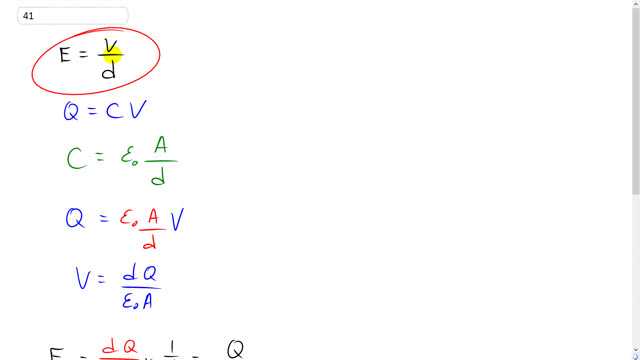
If a capacitor has opposite charges on the plates, and an electric field of 2.0 kV/mm is desired between the plates, what must each plate’s area be?

In order to watch this solution you need to have a subscription.
This is Giancoli Answers with Mr. Dychko. So we start with three formulas that we have to stitch together to get our answer. First we know that the when you have a constant electric field between two parallel plates. It's going to equal the potential difference between the plates V divided by the separation between them d And the charge on each plate of a capacitor is its capacitance times the voltage and then capacitance for a parallel plate capacitor is permittivity of free space times A divided by d area of each plate divided by the separation and we can replace this C in the formula for Q with this here. So we have Q is Epsilon naught A over d times V and solve that for V by multiplying both sides by d and dividing by Epsilon naught A and you get V is d Q over Epsilon naught A and then this V can get substituted into this formula for the electric field. So that's d Q over Epsilon naught A divided by d which is the same as multiplying by the reciprocal of d so multiplying by one over d . And it's easier to see that these cancel and Electric field then is the charge in each plate divided by permittivity of free space and divided by A area. So we can multiply this by area and divide by electric field and you get this line here. Area is charge divided by Epsilon naught E so, it's 4.2 times ten to the minus six coulombs charge in each plate divided by 8.85 times ten to the minus 12 permittivity of free space times the electric field between them of 2.0 times ten to the three volts per one times ten to the minus three meters. So notice the bit of trickery that they did there where they wrote 2.0 kilovolts per millimeter and you have to get rid of these prefixes kilo and Milla and write times ten to the three in place of the kilo and then times ten to the minus three in place of the Milla so that you get volts per meter and we end up with 0.24 meter squared.